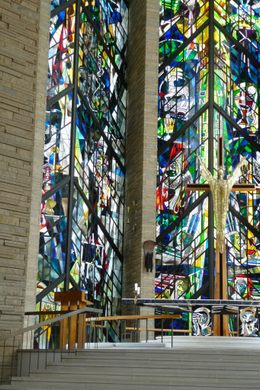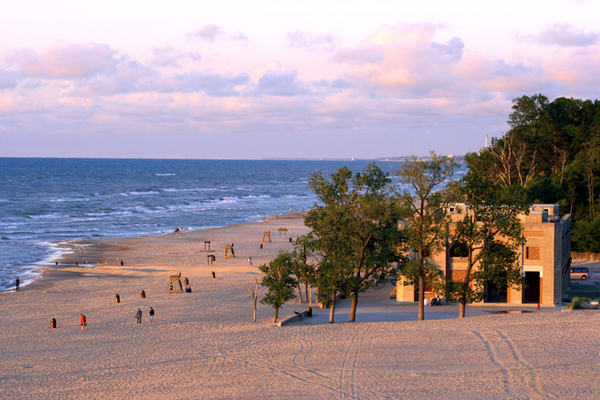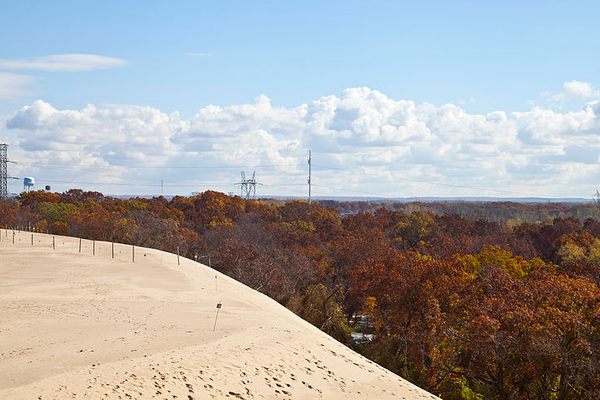Chapel of the Resurrection at Valparaiso University
This midcentury chapel is a bold architectural statement and a symbol of Indiana's Lutheran heritage.
The Chapel of the Resurrection was built and dedicated in 1959, and it was just as bold an architectural statement then as it is today. It is the towering focal point of Valparaiso University’s suburban campus and a strong reminder of its Lutheran character and heritage. The building is the largest collegiate chapel in the United States, and has become a nationally recognized symbol for the university and regional northwestern Indiana.
The Chapel’s main worship space is designed to focus visitors’ attention in one direction, and those who oblige will not be disappointed. Walking the length of the building’s nave, the unadorned, solid* red brick walls lead toward the dazzling, light-filled chancel.
This is where the Chapel pulls out all the architectural stops. The golden Christus rex floats above the altar, perfectly framed in the star-shaped room. The ceiling is more than 100 feet tall, and the walls seem to be made almost entirely of glass. Three of these window-walls are floor-to-ceiling stained glass, showering the whole space with beautiful, colored light. Look closer and the windows begin to reveal scenes from the Bible, history and education. The sight is simply breathtaking, and even in this age of 21st century technological glitz, modern viewers will (and should!) succumb to the urge to take a seat and marvel for a while.
Other details of the building’s design are worth noting as well. Stairs on either side of the altar lead below to the smaller Gloria Christi chapel, used for more intimate services or recitals. Back on the main floor, if you spin to face the way you came, the nave walls reveal themselves to be not so solid after all. Instead it’s a series of staggered sections, broken up by floor-to-ceiling windows that beam light into the room, forward toward the altar. These windows are intentionally invisible as you approach the altar; they are only unveiled on the way back.
In other words, the building’s design means that worshippers enter in relative darkness, singularly drawn to the spectacularly lit chancel at the far end. There, a transformation takes place (you’ll feel it), and then the whole building shines as you return to the world, newly forgiven and perhaps a little more enlightened.
Looking backward, it is also impossible to ignore the magnitude of the Reddel Memorial pipe organ filling the rear wall. This is one of the largest instruments of its kind in the country, and is part of what makes the Chapel of the Resurrection a frequent stop for choirs, orchestras, holiday concerts and more. More than 5,500 pipes “float” on the wall — look for the horizontal trumpet-like ones! — and are controlled by a 4-manual console in the balcony. There are ranks of pipes (each with vastly different sounds) for every occasion and taste, which is good because Lutheran tradition is chock-full of sacred music from every period.
Beginning with Martin Luther’s own simple hymns, music has always been essential in the life and worship of Protestants. The rich tradition has only grown since Luther’s time, thanks in no small part to the works of titans like Johann Sebastian Bach, Johann Pachelbel, Felix Mendelssohn and Paul Manz (all Lutherans). This organ is a tribute to that heritage, and is worth hearing if possible. It’s frequently in use during the academic year, not only for weekly services and occasional concerts, but also for students taking private lessons or practicing.
When construction began on the Chapel in 1959, Valparaiso University (known as “Valpo” to insiders) was just a tidy collection of buildings nestled nearer to downtown, at the intersection of Freeman Street and College Avenue. The small school had just lost its historic chapel-auditorium building to fire, and a postwar spike in enrollment was straining its other housing and academic facilities. In response, the University began the march east, purchasing houses and the vacant land stretching all the way to then-rural Sturdy Road. One of the first priorities was to build and dedicate a new Chapel on its frontier, ushering in an unprecedented era of expansion in the school’s history.
The building itself was financed in part by the Lutheran Church - Missouri Synod and designed by architect Charles Stade to be the anchor around which the “new campus” would spread. And so it has. In the 50+ years since its construction, the land surrounding the Chapel has changed dramatically, and alumni from every era are subject to disorientation. To most students and professors, this land is no longer “new,” it’s just “campus,” home to the vast majority of Valpo’s administrative, academic and residential facilities. But one thing about campus hasn’t changed much, and that is the Chapel of the Resurrection’s role: at the physical center of campus, and at the spiritual center of the University.
Update: An addition to the Chapel was completed in fall 2015. Known as the Helge Center after its alumni benefactors, it connects to the Chapel at the rear and extends to the southeast. The expansion provides a few modern necessities (accessible restrooms, additional offices and larger practice space for musicians, etc.) but its design was careful to visually complement the Chapel’s iconic stance on campus. The low-slung, dark exterior shrinks in comparison with the Chapel’s tall, vibrant brick facade, and a courtyard separates the two buildings to preserve the light and airy views from those large, staggered window bays along the Chapel wall.
Know Before You Go
When classes are in session, the Chapel of the Resurrection is open to the public every day between 7 a.m. and 6 p.m. Call for summer hours and information: (219) 464-5093.
Service times (all during August-May): 10 a.m. Sundays, traditional Lutheran worship (75 min.);10 p.m. Sundays, Candlelight Evening Prayer Services (30 min.); 10 a.m. weekdays, Morning Prayer (20 min.); 10 p.m. Wednesdays, contemporary Christian worship ("Celebrate!")
Driving directions: The recommended scenic route for driving to/from the Chapel from any direction (except west; see below) is via the main campus entrance on US-30. Consider stopping at the University's visitor center immediately on the left to grab a campus map; driving, parking and sidewalk navigation on campus can be tricky! Otherwise follow the road where it leads. You'll soon encounter a silly stop sign behind a building where you can only turn right. Do so, then turn right (north) again at the next stop sign. Continue, then turn right again at the stop sign onto Chapel Drive. Follow directions below.
Driving from the west/downtown, it's easiest to take Union Street straight east until it becomes Chapel Drive. Look for visitor parking in Lot 15 on the north side of the street just past McIntyre Court. The Chapel will be visible to the west; just look for the tall, stylized bell tower. (Handicap parking and dropoff is available at the entrance; just continue on Chapel Drive until it dead-ends.)
Community Contributors
Added by
Edited by
Plan Your Trip
The Atlas Obscura Podcast is Back!























Follow us on Twitter to get the latest on the world's hidden wonders.
Like us on Facebook to get the latest on the world's hidden wonders.
Follow us on Twitter Like us on Facebook